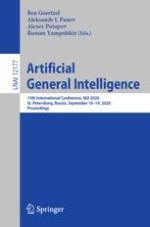2020 | Buch
Artificial General Intelligence
13th International Conference, AGI 2020, St. Petersburg, Russia, September 16–19, 2020, Proceedings
herausgegeben von: Ben Goertzel, Aleksandr I. Panov, Alexey Potapov, Prof. Dr. Roman Yampolskiy
Verlag: Springer International Publishing
Buchreihe : Lecture Notes in Computer Science
